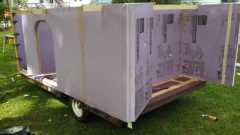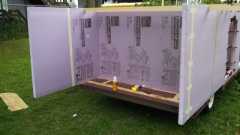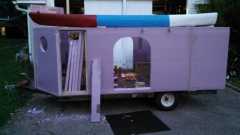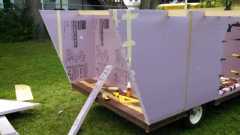Now I was back to the galley, this is the part that gave my project a new name. I had been using the name Skyline, but once this part was complete, I had to give it a new name. The galley lid design is different, and gives the whole tear a radical look, shut or open.

here I'm using my butterfly scarph joint to make the foam longer, I need the length for my wingback galley lid.


for the fun of it, I threw my foam kayak Sawfish, on the roof. I was planning on making the sidewalls 6" taller, but after putting a boat on the roof, I realized I didn't want any more height to have to deal with. Sawfish is a 23 lb boat, but I don't want to have to deal with ladders to put boats on it, or to deal with the sidewalls of the upper cabin any higher.
Full details on sawfish here, two time prize winner on instructables.com
https://www.facebook.com/media/set/?set ... 2a9935e7a1
with the sidewalls lengthened I could cut the galley lid walls to shape.

while these look like major tailfins, they are really the sides of the galley lid.
The normal tear curved hatch limits storage in the galley compared to a flat back end, but does give an overhead hatch for rain or sun shelter. The Mercury hatch gives more space for storage than a normal tear offers.
The Mercury hatch has no upward facing seams, other than the galley hinge itself, the easiest one to seal. Storm warning, my modified Benroy design is falling apart due to sealing issues with the galley hatch.
I have seen wind tunnel data that shows that the air flow does not follow the curved hatch of a teardrop much past the hinge point anyway, so this rear end treatment won't be a big drag.
A flat galley hatch doesn't lift high enough to clear your head when you get in close to the galley, unless the roof line is high to begin with.
The Mercury galley lid slopes the opposite way from the hinge to give the extra height needed for headroom when open.
